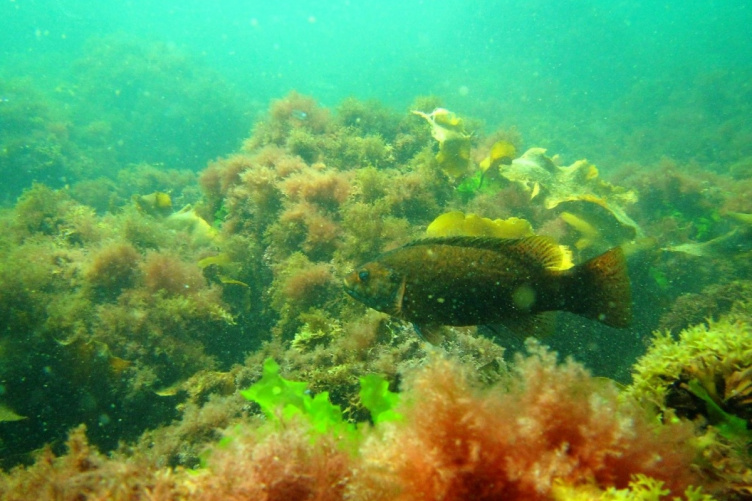
A cunner seeking refuge among a mix of "turf algae" species, including Dasysiphonia japonica (red seaweed in foreground) and Saccharina latissima (golden blades) in background. (Photo: Brandon O'Brien)
If you’re trying to hide from predators, you’ll probably choose a forest over a freshly mown lawn. It turns out cunners, fish from the wrasse family that live along the coastline of the western Atlantic Ocean, make the same choice. But new research from UNH has found that as their “forest” hiding places — towering blades of seaweed, like kelp — are replaced by invasive shorter algae, they’re changing behavior and possibly becoming more vulnerable.
These findings will not only help us understand increasing vulnerability of the cunner, both predator and prey of important fisheries like lobsters and pollock, but also enhance understanding and even prediction of a changing Gulf of Maine ecosystem.
“By losing their preferred refuge, the tall canopy-forming kelps, cunner were left with little option but to use the lower invasive seaweed turfs, which could give them less protection.”
The researchers conducted three experiments for their study, recently published in the Journal of Experimental Marine Biology and Ecology. “In each case, the cunner preferred and sought out the kelp, or similar seaweed species, to hide in,” says Jennifer Dijkstra, research assistant professor in the Center for Coastal and Ocean Mapping at UNH. “Over and over, they gravitated to the kelp that is taller and, because of its blade-like structure, provides a canopy to hide under.”
The researchers videotaped cunner in their natural habitat (nine sites along the coast of southern Maine and the Isles of Shoals) as they sought refuge or foraged for food; there, the cunner chose the kelp forests almost three times as much as the low-lying turf algae. In addition, the team, led by UNH doctoral student Brandon O’Brien, set up two controlled studies in the lab at Shoals Marine Laboratory on Appledore Island to watch how cunner chose different seaweed scenarios for hiding and feeding. They found that while kelp was the refuge of choice, the cunner showed no preference in seaweed habitats for foraging.
“Our results suggest that the refuge-seeking behavior of the cunner may be affected by the ongoing shift we have seen in our earlier studies of the increased dominance of the Dasysiphonia japonica in the southern Gulf of Maine,” says Dijkstra, referring to the introduced low-lying red algae spreading rapidly through New England. “By losing their preferred refuge, the tall canopy-forming kelps, cunner were left with little option but to use the lower invasive seaweed turfs, which could give them less protection.”
Interested in all-things marine?
Here's how Emily Ray '20 parlayed a passion for sharks into a double major.

The coastal research video showed three species — striped bass, pollock and harbor seals — known to be predators of cunner, highlighting the real threat to cunner in the surveyed habitats. While this study did not directly measure predation, the researchers believe that cunner may become more vulnerable prey since they were easily seen by the researchers hiding in the lower, less dense seaweed. They also note this could be even more detrimental to juvenile cunner, who seek safe refuge more often. While further studies are needed, they caution that continued reduction in available kelp cover may signal the beginning of a decline in cunner populations which may have cascading effects on other members of the Gulf of Maine ecosystem.
This work builds on previous research from Dijkstra and her team that looked at seaweed populations over the last 30 years in the southwestern Gulf of Maine and found the once predominant and towering kelp seaweed beds are declining and more invasive shrub-like species have taken their place. The invasive fiber-like red seaweeds had covered up to 50 to 60 percent of some areas, altering the look of the ocean floor and the base of the marine food chain.
In addition to Dijkstra and O’Brien, co-authors on this study, all from UNH, are Kristen Mello '14, research technician, and Amber Litterer '16, Shoals Marine Laboratory.
This project was supported by the Rutman Foundation through the Shoals Marine Laboratory and by UNH’s School of Marine Science and Ocean Engineering.
-
Written By:
Beth Potier | UNH Marketing | beth.potier@unh.edu | 2-1566
















































